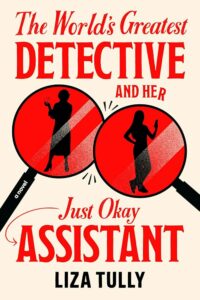 This series debut was a complete delight. Lead character Aubrey Merritt, the “Greatest Detective,” is a 60 something lady with a pristine reputation for cracking difficult cases, clearly cast in the Sherlock Holmes mold. As the book opens, she finds her somewhat hapless Watson in the person of assistant Olivia Blunt, an obsessed low level stalker who had always dreamt of working for Merritt. When she’s hired, she happily jettisons her job and informs her fiancé she’ll be away on a case, only to realize too late it might mean missing his off-Broadway debut. She hopes very much to be back in time, and he’s completely supportive, though he does fruitlessly beg her throughout the book to please call his mother, who is planning their wedding.
This series debut was a complete delight. Lead character Aubrey Merritt, the “Greatest Detective,” is a 60 something lady with a pristine reputation for cracking difficult cases, clearly cast in the Sherlock Holmes mold. As the book opens, she finds her somewhat hapless Watson in the person of assistant Olivia Blunt, an obsessed low level stalker who had always dreamt of working for Merritt. When she’s hired, she happily jettisons her job and informs her fiancé she’ll be away on a case, only to realize too late it might mean missing his off-Broadway debut. She hopes very much to be back in time, and he’s completely supportive, though he does fruitlessly beg her throughout the book to please call his mother, who is planning their wedding.
Merritt informs Olivia that she’ll be driving, and they take off to Lake Champlain in her decrepit and noisy car, Horace (I’m surprised it made the whole trip, having owned a couple of Horace like vehicles of my own). They’ve been asked by the daughter of a recent alleged suicide to look into her mother’s death, as the daughter is sure it’s really a case of murder. This is a murder mystery novel, so the answer to that question ought to be obvious.
The dead woman was the widowed owner of a wealthy man who left his resort empire to her. When they married (she was the second wife) he already had two children, and together, they had two more. Her stepchildren do not seem overly fond of her, but otherwise she appears to have been a joyful, generous woman who enjoyed her life to the fullest, a big reason her daughter Haley is so mystified by her apparent suicide.
Because of Merritt’s reputation, the local police welcome her assistance, and she in turn promises to share anything she discovers. Detectives Merritt and Olivia are polar opposites, with Merritt being logical and unemotional, with a photographic memory, even though she demands Olivia document in detail everything they uncover. Olivia is emotional, unsure of herself, and hugely empathic, something Merritt seems to be continually warning her against. But of course, it’s the combination of their two contrasting personalities and traits that makes for mystery magic.
As they interview each suspect – family members, the dead woman’s boyfriend, and an accountant named – ahem – Arthur Doyle – the pieces begin to come together, at least for Merritt. To Olivia it’s more of a through the glass darkly situation, though she manages to uncover some salient facts that she is ultimately able to put together into a solution.
The book ends with the traditional summing up, as the master detective goes through each relevant suspect in turn, finally landing on the killer. This is all done with such a light and intelligent hand that the result is pure reading joy from beginning to end. The updating of Holmes-Watson has of course been done before, but this take is done exceptionally well, and I very much look forward to the next instalment. — Robin Agnew